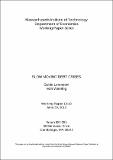| dc.contributor.author | Lorenzoni, Guido | |
| dc.contributor.author | Werning, Ivan | |
| dc.date.accessioned | 2013-10-28T23:29:05Z | |
| dc.date.available | 2013-10-28T23:29:05Z | |
| dc.date.issued | 2013-06-30 | |
| dc.identifier.uri | http://hdl.handle.net/1721.1/81817 | |
| dc.description.abstract | What circumstances or policies leave sovereign borrowers at the mercy of self-fulfilling increases in interest rates? To answer this question, we study the dynamics of debt and interest rates in a model where default is driven by insolvency. Fiscal deficits and surpluses are subject to shocks but influenced by a fiscal policy rule. Whenever possible the government issues debt to meet its current obligations and defaults otherwise. We show that low and high interest rate equilibria may coexist. Higher interest rates, prompted by fears of default, lead to faster debt accumulation, validating default fears. We call such an equilibrium a slow moving crisis, in contrast to rollover crises where investor runs precipitate immediate default. We investigate how the existence of multiple equilibria is affected by the fiscal policy rule, the maturity of debt, and the level of debt. | en_US |
| dc.publisher | Cambridge, MA: Department of Economics, Massachusetts Institute of Technology | en_US |
| dc.relation.ispartofseries | Working paper, Massachusetts Institute of Technology;13-18 | |
| dc.subject | debt crises, multiplicity, self-fulfilling crisis, sovereign debt | en_US |
| dc.title | Slow Moving Debt Crises | en_US |
| dc.type | Working Paper | en_US |
